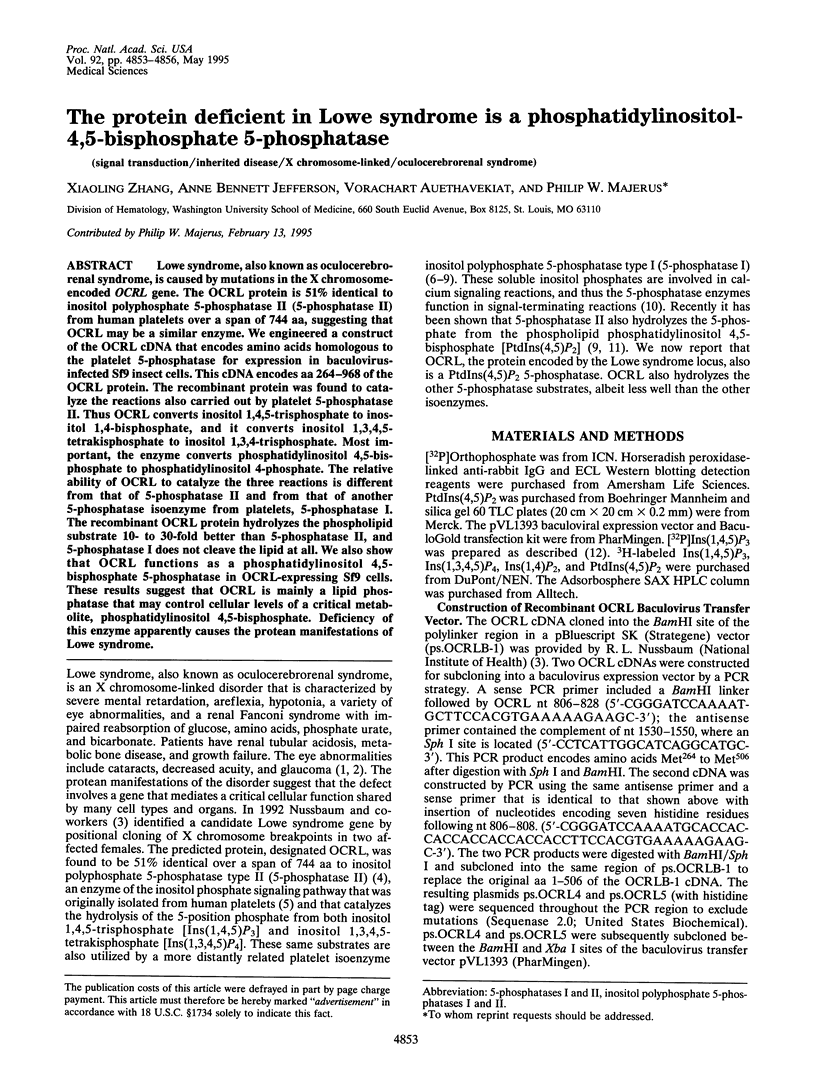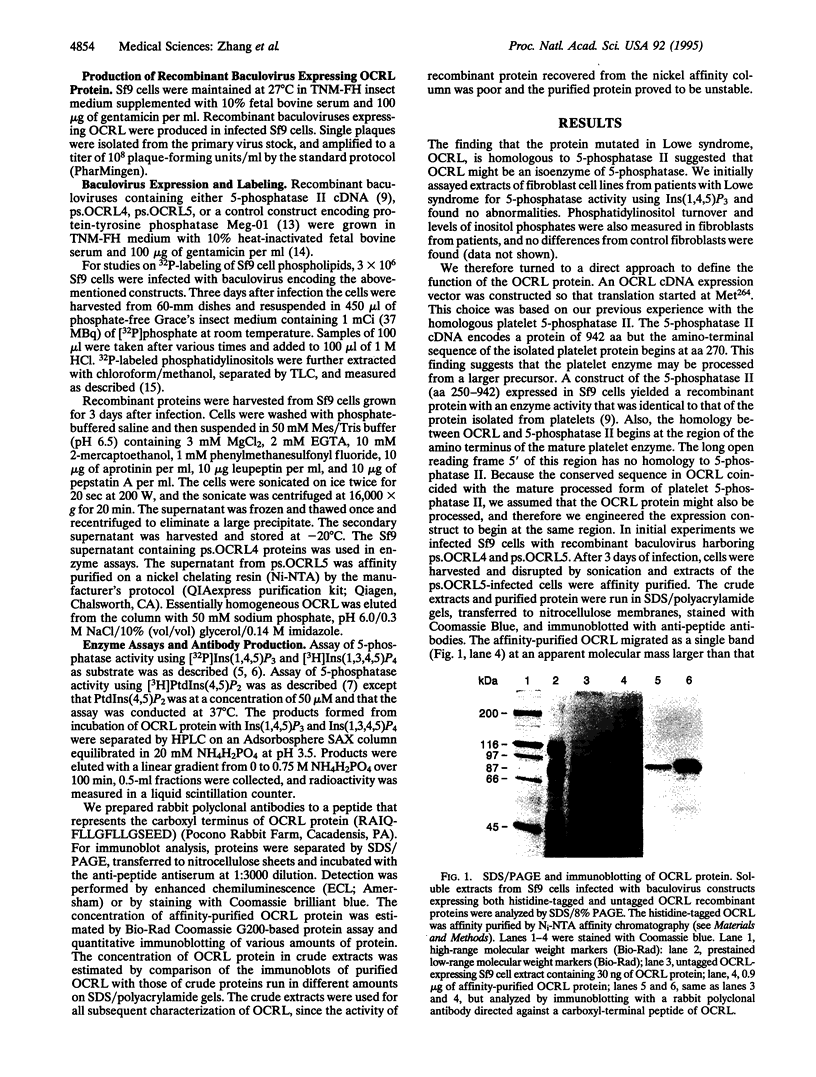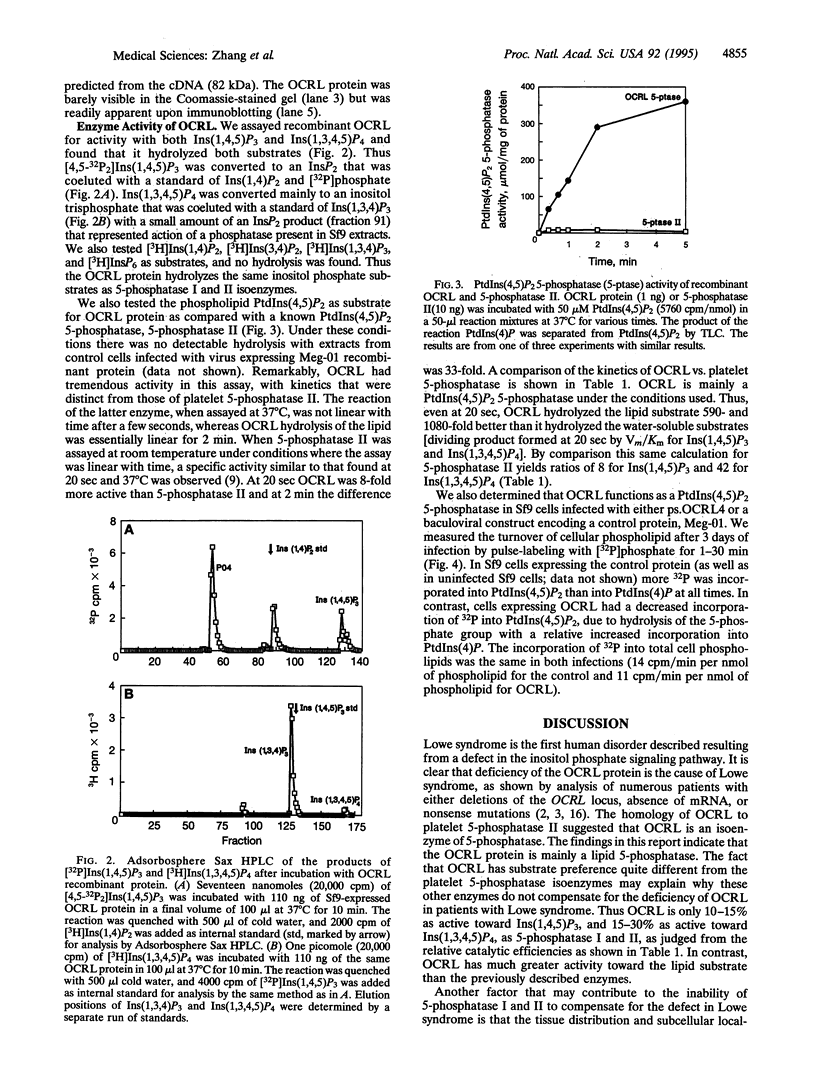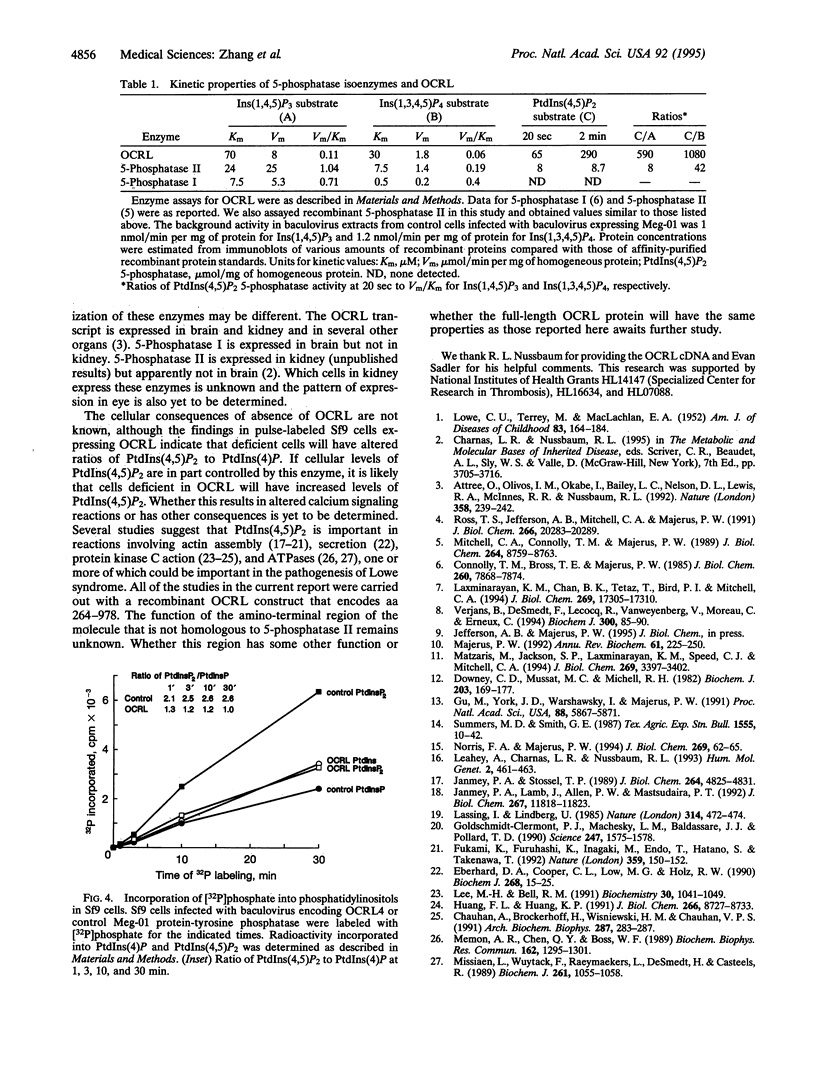Abstract
Lowe syndrome, also known as oculocerebrorenal syndrome, is caused by mutations in the X chromosome-encoded OCRL gene. The OCRL protein is 51% identical to inositol polyphosphate 5-phosphatase II (5-phosphatase II) from human platelets over a span of 744 aa, suggesting that OCRL may be a similar enzyme. We engineered a construct of the OCRL cDNA that encodes amino acids homologous to the platelet 5-phosphatase for expression in baculovirus-infected Sf9 insect cells. This cDNA encodes aa 264-968 of the OCRL protein. The recombinant protein was found to catalyze the reactions also carried out by platelet 5-phosphatase II. Thus OCRL converts inositol 1,4,5-trisphosphate to inositol 1,4-bisphosphate, and it converts inositol 1,3,4,5-tetrakisphosphate to inositol 1,3,4-trisphosphate. Most important, the enzyme converts phosphatidylinositol 4,5-bisphosphate to phosphatidylinositol 4-phosphate. The relative ability of OCRL to catalyze the three reactions is different from that of 5-phosphatase II and from that of another 5-phosphatase isoenzyme from platelets, 5-phosphatase I. The recombinant OCRL protein hydrolyzes the phospholipid substrate 10- to 30-fold better than 5-phosphatase II, and 5-phosphatase I does not cleave the lipid at all. We also show that OCRL functions as a phosphatidylinositol 4,5-bisphosphate 5-phosphatase in OCRL-expressing Sf9 cells. These results suggest that OCRL is mainly a lipid phosphatase that may control cellular levels of a critical metabolite, phosphatidylinositol 4,5-bisphosphate. Deficiency of this enzyme apparently causes the protean manifestations of Lowe syndrome.
Full text
PDF



Images in this article
Selected References
These references are in PubMed. This may not be the complete list of references from this article.
- Attree O., Olivos I. M., Okabe I., Bailey L. C., Nelson D. L., Lewis R. A., McInnes R. R., Nussbaum R. L. The Lowe's oculocerebrorenal syndrome gene encodes a protein highly homologous to inositol polyphosphate-5-phosphatase. Nature. 1992 Jul 16;358(6383):239–242. doi: 10.1038/358239a0. [DOI] [PubMed] [Google Scholar]
- Chauhan A., Brockerhoff H., Wisniewski H. M., Chauhan V. P. Interaction of protein kinase C with phosphoinositides. Arch Biochem Biophys. 1991 Jun;287(2):283–287. doi: 10.1016/0003-9861(91)90480-7. [DOI] [PubMed] [Google Scholar]
- Connolly T. M., Bross T. E., Majerus P. W. Isolation of a phosphomonoesterase from human platelets that specifically hydrolyzes the 5-phosphate of inositol 1,4,5-trisphosphate. J Biol Chem. 1985 Jul 5;260(13):7868–7874. [PubMed] [Google Scholar]
- Downes C. P., Mussat M. C., Michell R. H. The inositol trisphosphate phosphomonoesterase of the human erythrocyte membrane. Biochem J. 1982 Apr 1;203(1):169–177. doi: 10.1042/bj2030169. [DOI] [PMC free article] [PubMed] [Google Scholar]
- Eberhard D. A., Cooper C. L., Low M. G., Holz R. W. Evidence that the inositol phospholipids are necessary for exocytosis. Loss of inositol phospholipids and inhibition of secretion in permeabilized cells caused by a bacterial phospholipase C and removal of ATP. Biochem J. 1990 May 15;268(1):15–25. doi: 10.1042/bj2680015. [DOI] [PMC free article] [PubMed] [Google Scholar]
- Fukami K., Furuhashi K., Inagaki M., Endo T., Hatano S., Takenawa T. Requirement of phosphatidylinositol 4,5-bisphosphate for alpha-actinin function. Nature. 1992 Sep 10;359(6391):150–152. doi: 10.1038/359150a0. [DOI] [PubMed] [Google Scholar]
- Goldschmidt-Clermont P. J., Machesky L. M., Baldassare J. J., Pollard T. D. The actin-binding protein profilin binds to PIP2 and inhibits its hydrolysis by phospholipase C. Science. 1990 Mar 30;247(4950):1575–1578. doi: 10.1126/science.2157283. [DOI] [PubMed] [Google Scholar]
- Gu M. X., York J. D., Warshawsky I., Majerus P. W. Identification, cloning, and expression of a cytosolic megakaryocyte protein-tyrosine-phosphatase with sequence homology to cytoskeletal protein 4.1. Proc Natl Acad Sci U S A. 1991 Jul 1;88(13):5867–5871. doi: 10.1073/pnas.88.13.5867. [DOI] [PMC free article] [PubMed] [Google Scholar]
- Hart M. J., Eva A., Zangrilli D., Aaronson S. A., Evans T., Cerione R. A., Zheng Y. Cellular transformation and guanine nucleotide exchange activity are catalyzed by a common domain on the dbl oncogene product. J Biol Chem. 1994 Jan 7;269(1):62–65. [PubMed] [Google Scholar]
- Huang F. L., Huang K. P. Interaction of protein kinase C isozymes with phosphatidylinositol 4,5-bisphosphate. J Biol Chem. 1991 May 15;266(14):8727–8733. [PubMed] [Google Scholar]
- Janmey P. A., Lamb J., Allen P. G., Matsudaira P. T. Phosphoinositide-binding peptides derived from the sequences of gelsolin and villin. J Biol Chem. 1992 Jun 15;267(17):11818–11823. [PubMed] [Google Scholar]
- Janmey P. A., Stossel T. P. Gelsolin-polyphosphoinositide interaction. Full expression of gelsolin-inhibiting function by polyphosphoinositides in vesicular form and inactivation by dilution, aggregation, or masking of the inositol head group. J Biol Chem. 1989 Mar 25;264(9):4825–4831. [PubMed] [Google Scholar]
- LOWE C. U., TERREY M., MacLACHLAN E. A. Organic-aciduria, decreased renal ammonia production, hydrophthalmos, and mental retardation; a clinical entity. AMA Am J Dis Child. 1952 Feb;83(2):164–184. doi: 10.1001/archpedi.1952.02040060030004. [DOI] [PubMed] [Google Scholar]
- Lassing I., Lindberg U. Specific interaction between phosphatidylinositol 4,5-bisphosphate and profilactin. Nature. 1985 Apr 4;314(6010):472–474. doi: 10.1038/314472a0. [DOI] [PubMed] [Google Scholar]
- Laxminarayan K. M., Chan B. K., Tetaz T., Bird P. I., Mitchell C. A. Characterization of a cDNA encoding the 43-kDa membrane-associated inositol-polyphosphate 5-phosphatase. J Biol Chem. 1994 Jun 24;269(25):17305–17310. [PubMed] [Google Scholar]
- Leahey A. M., Charnas L. R., Nussbaum R. L. Nonsense mutations in the OCRL-1 gene in patients with the oculocerebrorenal syndrome of Lowe. Hum Mol Genet. 1993 Apr;2(4):461–463. doi: 10.1093/hmg/2.4.461. [DOI] [PubMed] [Google Scholar]
- Lee M. H., Bell R. M. Mechanism of protein kinase C activation by phosphatidylinositol 4,5-bisphosphate. Biochemistry. 1991 Jan 29;30(4):1041–1049. doi: 10.1021/bi00218a023. [DOI] [PubMed] [Google Scholar]
- Lips D. L., Majerus P. W., Gorga F. R., Young A. T., Benjamin T. L. Phosphatidylinositol 3-phosphate is present in normal and transformed fibroblasts and is resistant to hydrolysis by bovine brain phospholipase C II. J Biol Chem. 1989 May 25;264(15):8759–8763. [PubMed] [Google Scholar]
- Majerus P. W. Inositol phosphate biochemistry. Annu Rev Biochem. 1992;61:225–250. doi: 10.1146/annurev.bi.61.070192.001301. [DOI] [PubMed] [Google Scholar]
- Matzaris M., Jackson S. P., Laxminarayan K. M., Speed C. J., Mitchell C. A. Identification and characterization of the phosphatidylinositol-(4, 5)-bisphosphate 5-phosphatase in human platelets. J Biol Chem. 1994 Feb 4;269(5):3397–3402. [PubMed] [Google Scholar]
- Memon A. R., Chen Q. Y., Boss W. F. Inositol phospholipids activate plasma membrane ATPase in plants. Biochem Biophys Res Commun. 1989 Aug 15;162(3):1295–1301. doi: 10.1016/0006-291x(89)90814-0. [DOI] [PubMed] [Google Scholar]
- Missiaen L., Wuytack F., Raeymaekers L., De Smedt H., Casteels R. Polyamines and neomycin inhibit the purified plasma-membrane Ca2+ pump by interacting with associated polyphosphoinositides. Biochem J. 1989 Aug 1;261(3):1055–1058. doi: 10.1042/bj2611055. [DOI] [PMC free article] [PubMed] [Google Scholar]
- Ross T. S., Jefferson A. B., Mitchell C. A., Majerus P. W. Cloning and expression of human 75-kDa inositol polyphosphate-5-phosphatase. J Biol Chem. 1991 Oct 25;266(30):20283–20289. [PubMed] [Google Scholar]
- Verjans B., De Smedt F., Lecocq R., Vanweyenberg V., Moreau C., Erneux C. Cloning and expression in Escherichia coli of a dog thyroid cDNA encoding a novel inositol 1,4,5-trisphosphate 5-phosphatase. Biochem J. 1994 May 15;300(Pt 1):85–90. doi: 10.1042/bj3000085. [DOI] [PMC free article] [PubMed] [Google Scholar]



